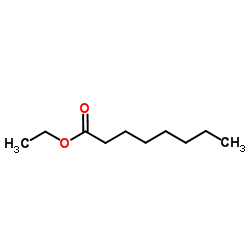Ethyl caprylate

Ethyl caprylate structure
|
Common Name | Ethyl caprylate | ||
|---|---|---|---|---|
| CAS Number | 106-32-1 | Molecular Weight | 172.265 | |
| Density | 0.9±0.1 g/cm3 | Boiling Point | 207.5±3.0 °C at 760 mmHg | |
| Molecular Formula | C10H20O2 | Melting Point | -47 °C | |
| MSDS | Chinese USA | Flash Point | 75.0±0.0 °C | |
|
Combined effects of nutrients and temperature on the production of fermentative aromas by Saccharomyces cerevisiae during wine fermentation.
Appl. Microbiol. Biotechnol. 99(5) , 2291-304, (2015) Volatile compounds produced by yeast during fermentation greatly influence the organoleptic qualities of wine. We developed a model to predict the combined effects of initial nitrogen and phytosterol content and fermentation temperature on the production of v... |
|
|
Olfactometry Profiles and Quantitation of Volatile Sulfur Compounds of Swiss Tilsit Cheeses.
J. Agric. Food Chem. 63 , 7511-21, (2015) To establish the odor profiles of three differently fabricated commercial Swiss Tilsit cheeses, analyses were conducted using headspace solid-phase microextraction gas chromatography-mass spectrometry/pulsed flame photometric detection and gas chromatography-... |
|
|
How do esters and dimethyl sulphide concentrations affect fruity aroma perception of red wine? Demonstration by dynamic sensory profile evaluation.
Food Chem. 194 , 196-200, (2015) Our study focused on variations in wine aroma perception and molecular composition during tasting over a period of 30min. In parallel, dynamic analytical and sensory methods were applied to study changes in the wines' molecular and aromatic evolution. Dynamic... |
|
|
Volatile Compounds from Grape Skin, Juice and Wine from Five Interspecific Hybrid Grape Cultivars Grown in Québec (Canada) for Wine Production.
Molecules 20 , 10980-1016, (2015) Developed from crosses between Vitis vinifera and North American Vitis species, interspecific hybrid grape varieties are becoming economically significant in northern areas, where they are now extensively grown for wine production. However, the varietal diffe... |
|
|
New method for the determination of bile acids in human plasma by liquid-phase microextraction using liquid chromatography-ion-trap-time-of-flight mass spectrometry.
J. Chromatogr. A. 1388 , 102-9, (2015) Bile acids (BAs) are derived from cholesterol and produced in the liver. The most abundant bile acids in humans are usually conjugated with glycine and taurine and are divided into primary BAs such as cholic acid (CA) and chenodeoxycholic acid (CDCA) and seco... |
|
|
Coping with matrix effects in headspace solid phase microextraction gas chromatography using multivariate calibration strategies.
J. Chromatogr. A. 1407 , 30-41, (2015) SPME is extremely sensitive to experimental parameters affecting liquid-gas and gas-solid distribution coefficients. Our aims were to measure the weights of these factors and to design a multivariate strategy based on the addition of a pool of internal standa... |
|
|
Olfactory Impact of Higher Alcohols on Red Wine Fruity Ester Aroma Expression in Model Solution.
J. Agric. Food Chem. 63 , 9777-88, (2015) This study focused on the impact of five higher alcohols on the perception of fruity aroma in red wines. Various aromatic reconstitutions were prepared, consisting of 13 ethyl esters and acetates and 5 higher alcohols, all at the average concentrations found ... |
|
|
Characterization of Volatile Flavor Compounds in Chinese Rice Wine Fermented from Enzymatic Extruded Rice.
J. Food Sci. 80 , C1476-89, (2015) Enzymatic extrusion, instead of traditional steam cooking, to treat rice is an efficient and alternative pretreatment for Chinese rice wine fermentation. In order to determine the formation of volatiles in enzymatic extrusion-processed rice wine (EE), and to ... |
|
|
Optimization, ex vivo permeation, and stability study of lipid nanocarrier loaded gelatin capsules for treatment of intermittent claudication.
Int. J. Nanomedicine 10 , 4459-78, (2015) In this study, an optimized nanodispersible oral dosage form (containing a lactate ester) was developed for cilostazol (CZL). CZL is a phosphodiesterase inhibitor used for intermittent claudication. We aimed to improve the dissolution rate and absorption of C... |
|
|
Water and temperature contribution to the structuration of starch matrices in the presence of flavour.
Food Chem. 195 , 79-86, (2015) The effect of modulating the gelatinisation extent by hydration (50/50 and 80/20 water to starch ratio) and temperature (65 or 85 °C) on various properties of wheat starch in presence of flavours has been studied. The hydrothermal treatments resulted in sampl... |